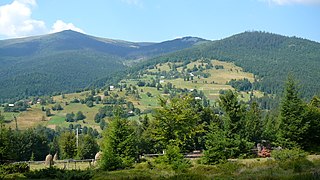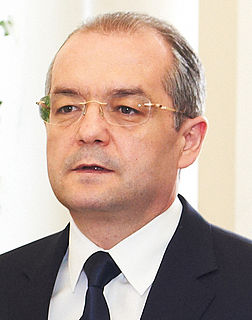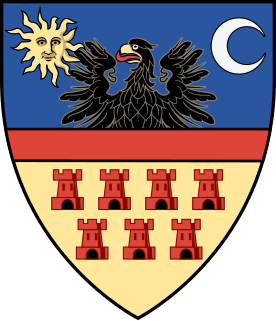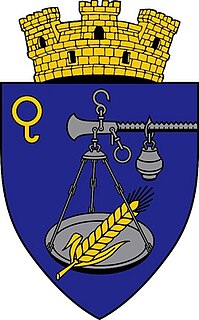
Transylvania is an historical region in central Romania. To the east and south its natural border is the Carpathian Mountains, and to the west the Apuseni Mountains. Broader definitions of Transylvania also encompass the western and northwestern Romanian regions of Crișana and Maramureș, and occasionally Banat.

Cluj-Napoca, or simply Cluj, is the fourth-most populous city in Romania. It is the seat of Cluj County in the northwestern part of the country. Geographically, it is roughly equidistant from Bucharest, Budapest and Belgrade. Located in the Someșul Mic river valley, the city is considered the unofficial capital of the historical province of Transylvania. From 1790 to 1848 and from 1861 to 1867, it was the official capital of the Grand Principality of Transylvania.

The coat of arms of Romania was adopted in the Romanian Parliament on 10 September 1992 as a representative coat of arms for Romania. It is based on the Lesser Coat of Arms of the Kingdom of Romania, redesigned by Victor Dima. As a central element, it shows a golden aquila holding a cross in its beak, and a mace and a sword in its claws. It also consists of the three colors which represent the colors of the national flag. The coat of arms was augmented on 11 July 2016 to add a representation of the Steel Crown of Romania.

Dej is a municipality in Transylvania, Romania, 60 kilometres (37 mi) north of Cluj-Napoca, in Cluj County. It lies where the river Someșul Mic meets the river Someșul Mare. The city administers four villages: Ocna Dejului (Désakna), Peștera (Pestes), Pintic (Oláhpéntek) and Șomcutu Mic (Kissomkút).
Gheorghe Funar is a nationalist Romanian politician, who rose to fame as a controversial mayor of Cluj-Napoca between 1992 and 2004.
Caritas was a Ponzi scheme in Romania that was active between April 1992 and August 1994. It attracted millions of depositors from all over the country, who invested more than a trillion old lei before it finally went bankrupt on 14 August 1994, having a debt of US$450 million.

Emil Boc is a Romanian politician who was Prime Minister of Romania from 22 December 2008 until 6 February 2012 and is the current Mayor of Cluj-Napoca, the largest city of Transylvania, where he was first elected in July 2004. Boc was also the president of the Democratic Liberal Party (PDL), which proposed and supported him as Prime Minister in late 2008, from December 2004 until July 2012.

The coat of arms of Bucharest is the heraldic symbol of the capital city of Romania. The present-day coat of arms was adopted by Domnitor Alexandru Ioan Cuza, and changed under the Communist regime. In 1994, it was renewed again with minor alterations.

The flag and coat of arms of Transylvania were granted by Maria Theresa in 1765, when she established a Grand Principality within the Habsburg monarchy. While neither symbol has official status in present-day Romania, the coat of arms is marshalled within the national Romanian arms; it was also for decades a component of the Hungarian arms. In its upper half, it prominently includes the eagle, which may have been one of the oldest regional symbols, or is otherwise a localized version of the Polish eagle. Early versions of the Transylvanian charges were first designed in Habsburg Hungary at some point before 1550, and were therefore symbols of pretence.

The Capitoline Wolf Statue in Cluj-Napoca, Romania is located on Eroilor Boulevard, in the city centre on the banks of the Someșul Mic River.

The Romanian government is the armiger in Romania. It exercises this right under the mandatory advice of the National Committee of Heraldry, Genealogy and Sigillography. The committee is subordinate to the Romanian Academy. All the coats of arms of Romanian institutions must be approved by this committee with two exceptions. The Romanian military is subject to the Ministry of National Defense Heraldric Committee, and Romanian law enforcement institutions are subject to the Ministry of Administration and Interior Heraldric Committee. Both of these committees may share members with the National Committee of Heraldry, Genealogy and Sigillography.
Iuliu Hațieganu University of Medicine and Pharmacy in Cluj-Napoca, Romania, is the oldest medical education institution in Transylvania, a continuation of the Faculty of Medicine which was founded in 1919, as a part of the Superior Dacia University. The university has over 6,000 national and international students, 2,400 resident physicians, as well as over 1,100 teachers and researchers. It was named in honor of the scientist Iuliu Hațieganu. The university is classified as an "advanced research and education university" by the Ministry of Education.
The history of Cluj-Napoca covers the time from the Roman conquest of Dacia, when a Roman settlement named Napoca existed on the location of the later city, through the founding of Cluj and its flourishing as the main cultural and religious center in the historical province of Transylvania, until its modern existence as a city, the seat of Cluj County in north-western Romania.
Editura Dacia is a publishing house based in Romania, located on Pavel Chinezul Street 2, Cluj-Napoca. Named after the ancient region of Dacia, it was founded in 1969 by a group of Transylvanian intellectuals, and printed works in Romanian, German and Hungarian.

The coat of arms of Buzău is the heraldic symbol standing for the city of Buzău, Romania. The city's first recorded coat of arms dates back to 1831, and since then, the coat of arms has mostly kept its features, under different designs.

The Franciscan Church is a place of worship in Cluj-Napoca, Romania. It was built between 1260 and 1290, on the site of an older Catholic church destroyed during the Tatar invasions in 1241.

Ruxandra-Mihaela Cesereanu or Ruxandra-Mihaela Braga is a Romanian poet, essayist, short story writer, novelist, and literary critic. Also known as a journalist, academic, literary historian and film critic, Cesereanu holds a teaching position at the Babeș-Bolyai University (UBB), and is an editor for the magazine Steaua in Cluj-Napoca.

The Piarist Church, located at 5 Str. Universității, Cluj-Napoca, Romania, and dedicated to the Holy Trinity, was the first Roman Catholic church built in Transylvania after the Protestant Reformation, as well as the province's first Baroque church building. Among the city's more notable edifices, it served as a prototype for numerous other churches in Transylvania. It features a strong contrast between the sober exterior and a very well-decorated, almost exuberant interior. A statue of the Virgin Mary stood in front of the church until 1959, when the Communist authorities moved it to another part of the city.

The Ethnographic Museum of Transylvania is situated in Cluj-Napoca, Romania. With a history of almost 100 years, the Ethnographic Museum of Transylvania is one of the first and greatest of its kind in Romania. It has two exhibition sections, one of which is to be found in downtown Reduta Palace, while the other exhibition section is the open-air Romulus Vuia Park situated on the city's north-west side, in Hoia Forest.

The coat of arms of Cimișlia is the official coat of arms of the city of Cimișlia, in the Cimișlia District, Moldova. It consists of a silver balance coming out of the coat of arms on the left and that holds an ear of grain representing the wealth of the city's cereals. On the canton (corner) of the coat of arms is the danga of a Tatar tribe, a unique symbol of Cimișlia. The field is blue, representing the sky and other values and elements. Above the coat of arms is a mural crown with three towers. It was proposed to use the coat of arms on the flag of Cimișlia, which was approved for a few months before the flag was changed again to its current form.

















